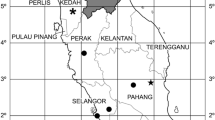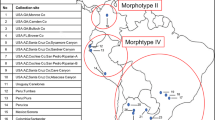Abstract
The taxonomy of the brown dog tick, Rhipicephalus sanguineus sensu lato (s.l.), is currently under discussion as there is no type and no proper description for this species (for recent detailed reviews, see Dantas-Torres and Otranto 2015 and Nava et al. 2015). Genetic and cross-breeding studies revealed that ticks morphologically identified as ‘R. sanguineus’ belong to at least two well-defined lineages, designated as temperate and tropical lineages (Burlini et al. 2010; Moraes-Filho et al. 2011; Nava et al. 2012), with additional operative taxonomic units being recently molecularly and morphologically identified (Dantas-Torres et al. 2013).
Access provided by CONRICYT-eBooks. Download chapter PDF
Similar content being viewed by others
Keywords
- Rhipicephalus Sanguineus
- Rhipicephalus Sanguineus Sensu Lato
- Tropical Lines
- Burlina
- Well-defined Lineages
These keywords were added by machine and not by the authors. This process is experimental and the keywords may be updated as the learning algorithm improves.
The taxonomy of the brown dog tick, R. sanguineus sensu lato (s.l.), is currently under discussion as there is no type and no proper description for this species (for recent detailed reviews, see Dantas-Torres and Otranto 2015; Nava et al. 2015). Genetic and cross-breeding studies revealed that ticks morphologically identified as ‘R. sanguineus’ belong to at least two well-defined lineages, designated as temperate and tropical lineages (Burlini et al. 2010; Moraes-Filho et al. 2011; Nava et al. 2012), with additional operative taxonomic units being recently molecularly and morphologically identified (Dantas-Torres et al. 2013). As the type locality was defined as ‘habitat in Gallia’ (Latreille 1806), the temperate lineage probably represents the actual R. sanguineus s.l. However, until a proper redescription of the species with the definition of the neotype is available, all ticks morphologically compatible with available descriptions of ‘R. sanguineus’ (e.g. Walker et al. 2000) should be referred to as R. sanguineus s.l (Guglielmone et al. 2014). In this chapter, we will provide general information available for R. sanguineus s.l.
Life Cycle and Host Preferences
Rhipicephalus sanguineus s.l. is a three-host tick. Under laboratory conditions, the life cycle may be completed in 2–4 months, depending on factors such as temperature and host availability (Dantas-Torres et al. 2011). Unfed adult ticks can survive for more than 1 year without taking a blood meal (Dantas-Torres et al. 2012). All developmental stages feed primarily on dogs, but eventually on other hosts, including rodents, birds and humans (for a review, see Dantas-Torres 2010).
Ecology
Rhipicephalus sanguineus s.l. is the most common tick found on dogs in urban areas around the world. This tick may also be highly prevalent in rural areas, but even in such areas, it is typically associated with dog shelters and human houses. Indeed, R. sanguineus s.l. is essentially a nidicolous tick found in close association with dogs. This tick is typically found in shelters and kennels where confined dogs may be highly infested. In houses with tick-infested dogs, R. sanguineus s.l. are usually found in the places where the dogs stay during the night, which may be a doghouse in the backyard or even inside the house. Engorged females are often found on the wall where they usually hide themselves in cracks and crevices, i.e. places where they are more protected from unsuitable weather conditions (Dantas-Torres 2010). Nonetheless, R. sanguineus s.l. ticks are well adapted to a range of climatic conditions. In particular, the so-called tropical lineage is usually found in regions with average mean temperatures >20 °C, whereas the temperate lineage is present in regions with average annual temperatures <20 °C (Zemtsova et al. 2016). In tropical and subtropical regions, R. sanguineus s.l. ticks can complete more than one generation per year (Silveira et al. 2009), whereas in temperate countries, they typically produce a single generation per year, occurring mainly from spring to autumn (Lorusso et al. 2010) and overwintering in southern Europe as adults (Ramos et al. 2014).
A–G The male of R. sanguineus s.l. A Dorsal, B ventral, C capitulum, dorsal, D capitulum, ventral, E spiracular plate; F hypostome, G coxae and trochanters I–IV. H–N The female of R. sanguineus s.l. H Dorsal, I ventral, J capitulum, dorsal, K capitulum, ventral, L spiracular plate; M hypostome, N coxae and trochanters I–IV. Illustrations from specimens collected in kennels in Portugal, Spain, France and Italy
A–F The nymph of R. sanguineus s.l. A Dorsal, B ventral, C capitulum, dorsal, D capitulum, ventral, E spiracular plate, F hypostome, G coxae and trochanters I–IV. H–M The larva of R. sanguineus s.l. H Dorsal, I ventral, J capitulum, dorsal, K capitulum, ventral, L hypostome, M coxae and trochanters I–III. Illustrations from a colony of ticks collected in southern France
Distribution
Rhipicephalus sanguineus s.l. has a cosmopolitan distribution, occurring mainly in the tropical and subtropical zones but also in temperate regions. Sporadic findings of brown dog ticks in northern countries (e.g. the UK, Hansford et al. 2014) have been published, but there is limited evidence indicating that these ticks could establish themselves permanently in such cold regions. The limits of its distribution range are thought to be from latitude 20°N to below 30°S for the temperate lineage (Burlini et al. 2010).
Vectorial Capacity and Pathogen Burden
Laboratory and field studies have implicated R. sanguineus s.l. in the transmission of numerous pathogens, including Babesia vogeli, Ehrlichia canis, Hepatozoon canis, Rickettsia conorii and Rickettsia rickettsii, among others (for complete review, see Dantas-Torres 2008). Different lineages of R. sanguineus s.l. appear to have different vector competences for certain pathogens, including E. canis (Moraes-Filho et al. 2015).
References
Burlini L, Teixeira KR, Szabó MP, Famadas KM (2010) Molecular dissimilarities of Rhipicephalus sanguineus (Acari: Ixodidae) in Brazil and its relation with samples throughout the world: is there a geographical pattern? Exp Appl Acarol 50:361–374
Dantas-Torres F (2008) The brown dog tick, Rhipicephalus sanguineus (Latreille, 1806) (Acari: Ixodidae): from taxonomy to control. Vet Parasitol 152:173–185
Dantas-Torres F (2010) Biology and ecology of the brown dog tick, Rhipicephalus sanguineus. Parasit Vectors 2010(3):26
Dantas-Torres F, Figueredo LA, Otranto D (2011) Seasonal variation in the effect of climate on the biology of Rhipicephalus sanguineus in southern Europe. Parasitology 138:527–536
Dantas-Torres F, Giannelli A, Otranto D (2012) Starvation and overwinter do not affect the reproductive fitness of Rhipicephalus sanguineus. Vet Parasitol 185:260–264
Dantas-Torres F, Latrofa MS, Annoscia G, Giannelli A, Parisi A, Otranto D (2013) Morphological and genetic diversity of Rhipicephalus sanguineus sensu lato from the new and old worlds. Parasit Vectors 6:213
Dantas-Torres F, Otranto D (2015) Further thoughts on the taxonomy and vector role of Rhipicephalus sanguineus group ticks. Vet Parasitol 208:9–13
Guglielmone AA, Robbins RG, Apanaskevich DA, Petney TN, Estrada-Peña A, Horak IG (2014) The hard ticks of the world (Acari: Ixodida: Ixodidae). Springer, Dordrecht, p 738
Hansford KM, Pietzsch ME, Cull B, Medlock JM (2014) Importation of R. sanguineus into the UK via dogs: tickborne diseases. Vet Rec 175:385–386
Latreille PA (1806) Genera crustaceorum et insectorum secundumordinem naturalem in familia disposita, iconibus exemplisqueplurimis explicata. Paris Argentorati 1:302
Lorusso V, Dantas-Torres F, Lia RP, Tarallo VD, Mencke N, Capelli G, Otranto D (2010) Seasonal dynamics of the brown dog tick, Rhipicephalus sanguineus, on a confined dog population in Italy. Med Vet Entomol 24:309–315
Moraes-Filho J, Krawczak FS, Costa FB, Soares JF, Labruna MB (2015) Comparative evaluation of the vector competence of four South American populations of the Rhipicephalus sanguineus group for the bacterium Ehrlichia canis, the agent of canine monocytic ehrlichiosis. PLoS ONE 10:e0139386
Moraes-Filho J, Marcili A, Nieri-Bastos FA, Richtzenhain LJ, Labruna MB (2011) Genetic analysis of ticks belonging to the Rhipicephalus sanguineus group in Latin America. Acta Trop 117:51–55
Nava S, Estrada-Peña A, Petney T, Beati L, Labruna MB, Szabó MP, Venzal JM, Mastropaolo M, Mangold AJ, Guglielmone AA (2015) The taxonomic status of Rhipicephalus sanguineus (Latreille, 1806). Vet Parasitol 208:2–8
Nava S, Mastropaolo M, Venzal JM, Mangold AJ, Guglielmone AA (2012) Mitochondrial DNA analysis of Rhipicephalus sanguineus sensu lato (Acari: Ixodidae) in the Southern Cone of South America. Vet Parasitol 190:547–555
Ramos RA, Giannelli A, Carbone D, Baneth G, Dantas-Torres F, Otranto D (2014) Occurrence of Hepatozoon canis and Cercopithifilaria bainae in an off-host population of Rhipicephalus sanguineus sensu lato ticks. Ticks Tick Borne Dis 5:311–314
Silveira JA, Passos LM, Ribeiro MF (2009) Population dynamics of Rhipicephalus sanguineus (Latrielle, 1806) in Belo Horizonte, Minas Gerais state, Brazil. Vet Parasitol 161:270–275
Walker JB, Keirans JE, Horak IG (2000) The genus Rhipicephalus (Acari, Ixodidae): a guide to the brown ticks of the world. Cambridge University Press, Cambridge
Zemtsova GE, Apanaskevich DA, Reeves WK, Hahn M, Snellgrove A, Levin ML (2016) Phylogeography of Rhipicephalus sanguineus sensu lato and its relationships with climatic factors. Exp Appl Acarol 69:191–203
Author information
Authors and Affiliations
Corresponding author
Editor information
Editors and Affiliations
Rights and permissions
Copyright information
© 2017 Springer International Publishing AG, part of Springer Nature
About this chapter
Cite this chapter
Dantas-Torres, F., Otranto, D. (2017). Rhipicephalus sanguineus s.l. (Latreille, 1806) (Figs. 127–129). In: Estrada-Peña, A., Mihalca, A., Petney, T. (eds) Ticks of Europe and North Africa. Springer, Cham. https://doi.org/10.1007/978-3-319-63760-0_62
Download citation
DOI: https://doi.org/10.1007/978-3-319-63760-0_62
Published:
Publisher Name: Springer, Cham
Print ISBN: 978-3-319-63759-4
Online ISBN: 978-3-319-63760-0
eBook Packages: Biomedical and Life SciencesBiomedical and Life Sciences (R0)







